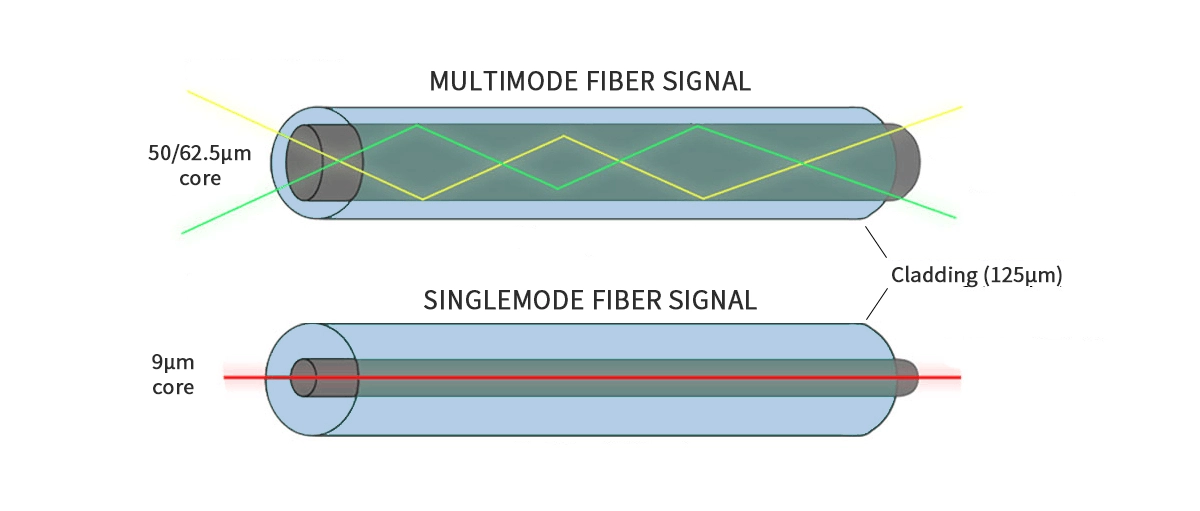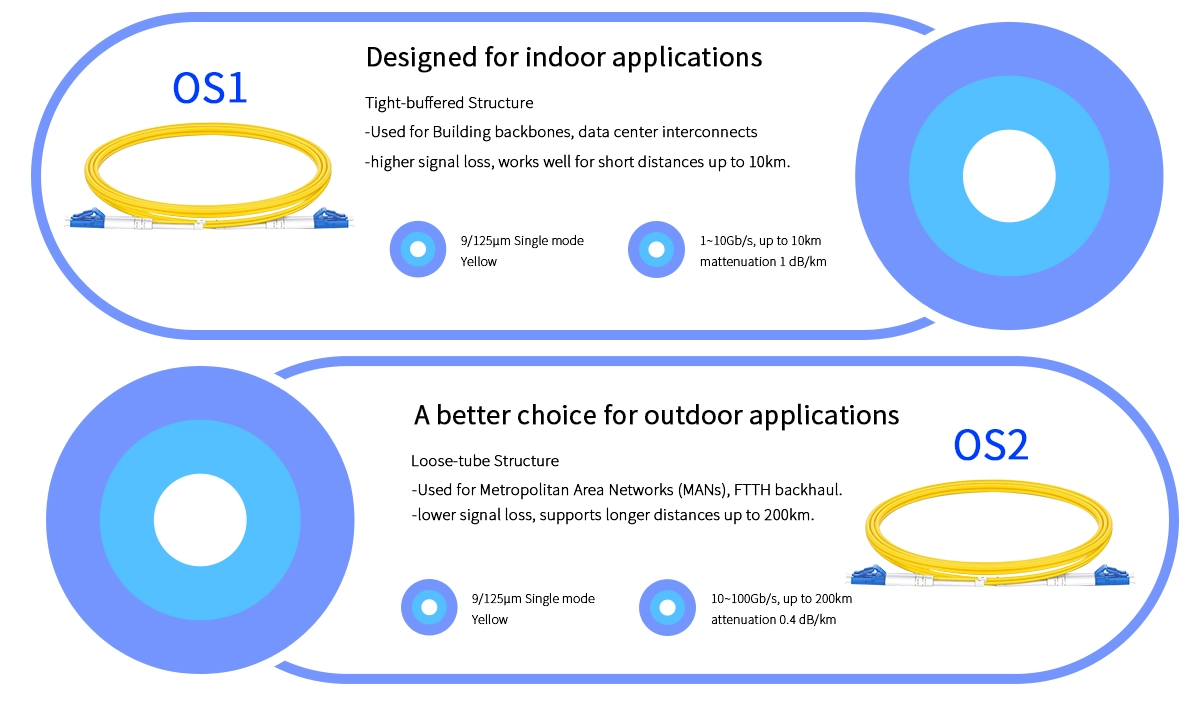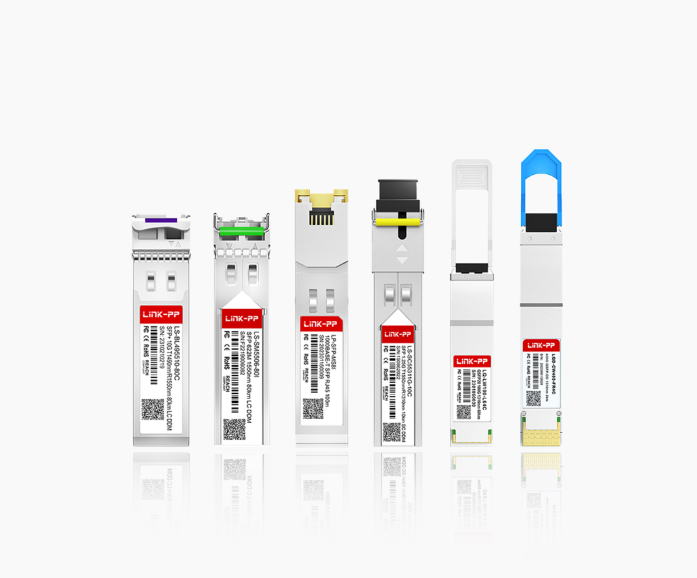
In the intricate world of fiber optic cabling, selecting the right single-mode fiber (SMF) type is paramount for performance, reach, and cost-efficiency. The terms OS1 and OS2 frequently surface, often causing confusion. While both are single-mode fibers designed for long-distance, high-bandwidth transmission, understanding the key differences between OS1 and OS2 fiber optic cable is essential for network designers, installers, and operators. Choosing incorrectly can lead to performance bottlenecks, unexpected attenuation, or unnecessary expenditure.
This comprehensive guide dives deep into the OS1 vs OS2 debate, clarifying their specifications, applications, and which is the optimal choice for your specific scenario. We'll also explore the critical role of compatible optical transceivers, including high-quality options from LINK-PP, in ensuring your network operates flawlessly.
Key Takeaways
OS1 fiber has a tight-buffered design. It is best for indoor use. OS2 fiber has a loose-tube design. It is made for outdoor and long-distance use.
OS1 works well for short distances up to 10km. It has higher signal loss. OS2 supports longer distances up to 200km. It has lower signal loss.
OS1 supports speeds up to 10GbE. This is good for most indoor networks. OS2 supports faster speeds up to 100GbE. It is great for large and future-proof networks.
Choose OS1 for short indoor runs that save money. Pick OS2 for outdoor, long-distance, or high-speed needs. OS2 is also good for future upgrades.
Picking the right fiber type helps your network work well now. It also keeps your network ready for growth and new technology later.
1. The Foundation: Single-Mode Fiber and Light Propagation

Before dissecting OS1 and OS2, recall that single-mode fiber is designed to carry a single ray of light (mode) directly down the fiber core. This core is significantly smaller (typically 9μm) compared to multimode fiber, eliminating modal dispersion and enabling vastly superior bandwidth and distance capabilities. Both OS1 and OS2 leverage this principle.
2. Defining OS1 Fiber: The Legacy Standard
Standard: OS1 (Optical Single-mode 1) is defined under older ITU-T G.652.A/B/C recommendations. It represents the traditional, widely deployed single-mode fiber.
Primary Application: Optimized for indoor fiber optic cabling applications within buildings, campuses, or controlled environments.
Attenuation: Historically specified with a maximum attenuation of 1.0 decibel per kilometer (dB/km) at the crucial 1310nm and 1550nm wavelengths. Modern manufacturing often achieves lower levels.
Bend Sensitivity: OS1 fiber is generally more sensitive to macrobending and microbending losses. Tight bends during fiber optic cable installation can cause significant signal loss.
Water Peak: Traditional OS1 fibers exhibit a pronounced "water peak" attenuation around the 1383nm wavelength (E-band), limiting its effective use in that range for CWDM applications.
Typical Use Cases: Building backbones, data center interconnects within a single facility or campus (distances typically under 10km), point-to-point links within controlled environments.
3. Defining OS2 Fiber: The Enhanced Performance Standard
Standard: OS2 (Optical Single-mode 2) aligns with the more modern ITU-T G.652.C/D recommendations. It represents the enhanced, performance-optimized single-mode fiber.
Primary Application: Designed for outdoor fiber optic cable runs and long-haul applications, including underground, aerial, and direct burial installations. Also ideal for high-density indoor environments.
Attenuation: Features a tighter maximum attenuation specification of 0.4 decibel per kilometer (dB/km) at both 1310nm and 1550nm wavelengths. This lower intrinsic loss directly translates to longer possible reach.
Bend Sensitivity: Engineered with significantly improved bend tolerance. OS2 fibers, especially those meeting G.652.D, are much more resistant to losses induced by bends encountered during installation or in cramped spaces like patch panels. This is crucial for OS2 fiber installation best practices.
Water Peak: OS2 fiber (specifically G.652.C/D) is manufactured as Low Water Peak (LWP) or Zero Water Peak (ZWP) fiber. This virtually eliminates the attenuation peak at 1383nm, opening up the entire spectrum from 1260nm to 1625nm for use. This is vital for maximizing channel count in Coarse Wavelength Division Multiplexing (CWDM) and Dense Wavelength Division Multiplexing (DWDM) systems.
Typical Use Cases: Metropolitan Area Networks (MANs), long-distance telecommunications, Fiber-to-the-Home (FTTH) backhaul, undersea cables, data center interconnects spanning cities or countries, and any application requiring maximum distance, bandwidth, or CWDM/DWDM utilization.
4. Comparing OS1 and OS2 Single Mode Fiber Features
Explore key differences between OS1 and OS2 single mode fibers.
Features | OS1 Fiber | OS2 Fiber |
|---|---|---|
Construction Type | Tight-buffered, indoor use | Loose-tube, outdoor use |
Attenuation Rate | ~1.0 dB/km signal loss | ~0.4 dB/km signal loss |
Maximum Distance | Up to 10km | Up to 200km |
Supported Speeds | Up to 10GbE | Up to 40G/100G Ethernet |
Application Environment | Indoor, short runs | Outdoor, long haul |
Water Resistance | Not water-blocked | Water-blocking gel inside tubes |
Standard Reference | ITU-T G.652 A/B | ITU-T G.652 C/D |
Wavelength Optimization | Primarily 1310nm | Extended bands including 1550nm |
Cost | Lower cost | Slightly higher cost |
Future-Proofing | Limited upgrade potential | Excellent for future upgrades |
What makes OS1 and OS2 single mode fiber different comes from a few important features. OS1 fiber has a tight-buffered build, so it works best inside buildings. OS2 fiber has a loose-tube build, which is better for outside use. The table below shows the main differences:
Feature | OS1 Fiber | OS2 Fiber |
|---|---|---|
Construction | Tight-buffered (indoor) | Loose-tube (outdoor) |
Attenuation | ~1.0 dB/km | ~0.4 dB/km |
Maximum Distance | Up to 10km | Up to 200km |
Supported Speeds | Up to 10GbE | Up to 40G/100G |
These differences change how you design networks, how well the fiber works, and which optical transceiver you need for each job. Picking the right single-mode fiber helps make sure your fiber optic system is fast and works well anywhere.
5. Compatibility and the Role of Optical Transceivers

Crucially, both OS1 and OS2 fibers use the same core size (typically 9μm). This means they are physically compatible with standard single-mode connectors (LC, SC, FC, ST) and crucially, with the same optical transceivers.
Transceiver Compatibility: A 10 Gigabit SFP+ optical transceiver designed for single-mode fiber (e.g., operating at 1310nm or 1550nm) will work over either OS1 or OS2 fiber. The transceiver doesn't "know" the fiber type; it simply transmits and receives light. LINK-PP SFP-10G-LR and LINK-PP SFP-10G-ER transceivers, for example, are fully compatible with both OS1 and OS2 fiber infrastructure.
Performance Dictated by Fiber: While the transceiver is compatible, the actual achievable distance and signal quality are directly determined by the fiber's characteristics (attenuation, bend loss) and the total link loss budget. An OS2 link will inherently allow for longer distances or more lossy components (like more connectors) than an OS1 link using the same transceiver type. Understanding your optical transceiver compatibility requirements with the fiber path is key.
6. Why OS2 is Often the Preferred Choice Today
While OS1 remains suitable for specific short, indoor applications, OS2 fiber offers significant advantages that make it the de facto standard for most new deployments, even some indoor ones:
Future-Proofing: OS2 supports the full spectrum, enabling easy adoption of CWDM/DWDM for massive capacity upgrades without replacing fiber. Planning for future-proof fiber optic networks is essential.
Longer Reach: Lower attenuation enables significantly longer link distances without requiring signal regeneration or more expensive transceivers.
Superior Bend Performance: Reduced sensitivity to bends simplifies installation, especially in space-constrained areas, and improves reliability. This is critical for OS2 fiber installation best practices in dense environments.
Versatility: Can be used both indoors and outdoors seamlessly. Using OS2 universally simplifies inventory and design.
Performance Headroom: Provides a lower loss baseline, offering more margin within the link loss budget for splices, connectors, and potential future degradation.
7. Choosing Between OS1 and OS2: Key Considerations

Selecting the right fiber type hinges on several factors:
Distance Requirements: Need > 10km? OS2 is mandatory. Shorter runs might technically work with OS1, but OS2 provides margin.
Environment: Outdoor plant, harsh conditions, or tight bends? OS2's robustness is essential. Purely controlled, static indoor trays? OS1 might suffice if distance is short.
Bandwidth & Wavelength Plans: Planning or potentially needing CWDM/DWDM? OS2 (G.652.D) is the only viable option due to its zero water peak.
Total Cost of Ownership (TCO): While OS2 cable might cost slightly more per meter upfront, its longer reach, bend tolerance, and future-proofing often lead to lower overall project costs by reducing the need for regeneration sites, enabling higher channel counts, and simplifying installation. Consider the cost of OS1 vs OS2 fiber optic cable holistically.
Existing Infrastructure: Integrating with older OS1 cable? Match the new section or carefully calculate the total loss budget.
8. The Critical Link: High-Performance Optical Transceivers
Regardless of whether you deploy OS1 or OS2 fiber, achieving optimal network performance relies on compatible, high-quality optical transceivers. LINK-PP offers a comprehensive range of reliable and standards-compliant transceivers designed for seamless integration with both fiber types:
Short Reach: LINK-PP SFP-1G-LX (1G), LINK-PP SFP-10G-LR (10G)
Extended Reach: LINK-PP SFP-10G-ER (40km), LINK-PP SFP-10G-ZR (80km)
DWDM Solutions: LINK-PP DWDM SFP+ modules for maximizing capacity over OS2 fiber.
Using genuine or compatible high-quality modules like those from LINK-PP ensures you meet the loss budgets specified for your OS1 or OS2 links and guarantees reliable, error-free transmission.
Conclusion: OS2 – The Clear Path Forward for Modern Networks
While OS1 fiber still has niche applications in very short, controlled indoor links, the difference between OS1 and OS2 overwhelmingly favors OS2 for the vast majority of modern network deployments. OS2's lower attenuation, superior bend tolerance, elimination of the water peak, and full spectrum usability provide essential advantages in reach, reliability, future capacity, and installation flexibility.
Ready to Optimize Your Fiber Network?
Choosing between OS1 and OS2 is a fundamental decision impacting your network's performance, scalability, and cost. When designing or upgrading your infrastructure, prioritize OS2 fiber to ensure you're building a foundation ready for today's demands and tomorrow's innovations.
Need expert advice on selecting the right fiber type and compatible optical transceivers for your specific project? Explore LINK-PP's extensive portfolio of high-performance optical transceivers, including SFP+, QSFP28, and DWDM modules, designed to deliver maximum reliability over both OS1 and OS2 fiber links.
FAQ
What is the main difference between OS1 and OS2 fiber?
OS1 fiber has a tight cover and is made for inside. OS2 fiber has a loose tube and is made for outside and long trips. OS2 lets the signal go farther and lose less strength.
Can OS2 fiber replace OS1 fiber in all installations?
OS2 fiber can be used in most places where OS1 is used. OS2 works better for sending data far. For short jobs inside, OS1 is still a good and cheap pick.
Which fiber type is better for future network upgrades?
OS2 fiber can send data faster and farther. It is better if your network will grow. OS1 is fine for small or inside networks right now.
How do OS1 and OS2 fibers compare in terms of cost?
Fiber Type | Typical Cost | Value for Money |
|---|---|---|
OS1 | Lower | Best for short runs |
OS2 | Slightly higher | Best for upgrades and long runs |
OS2 costs a little more but gives you more choices and better results.
See Also
OM1 OM2 OM3 OM4 OM5 Multimode Fibers Explained




